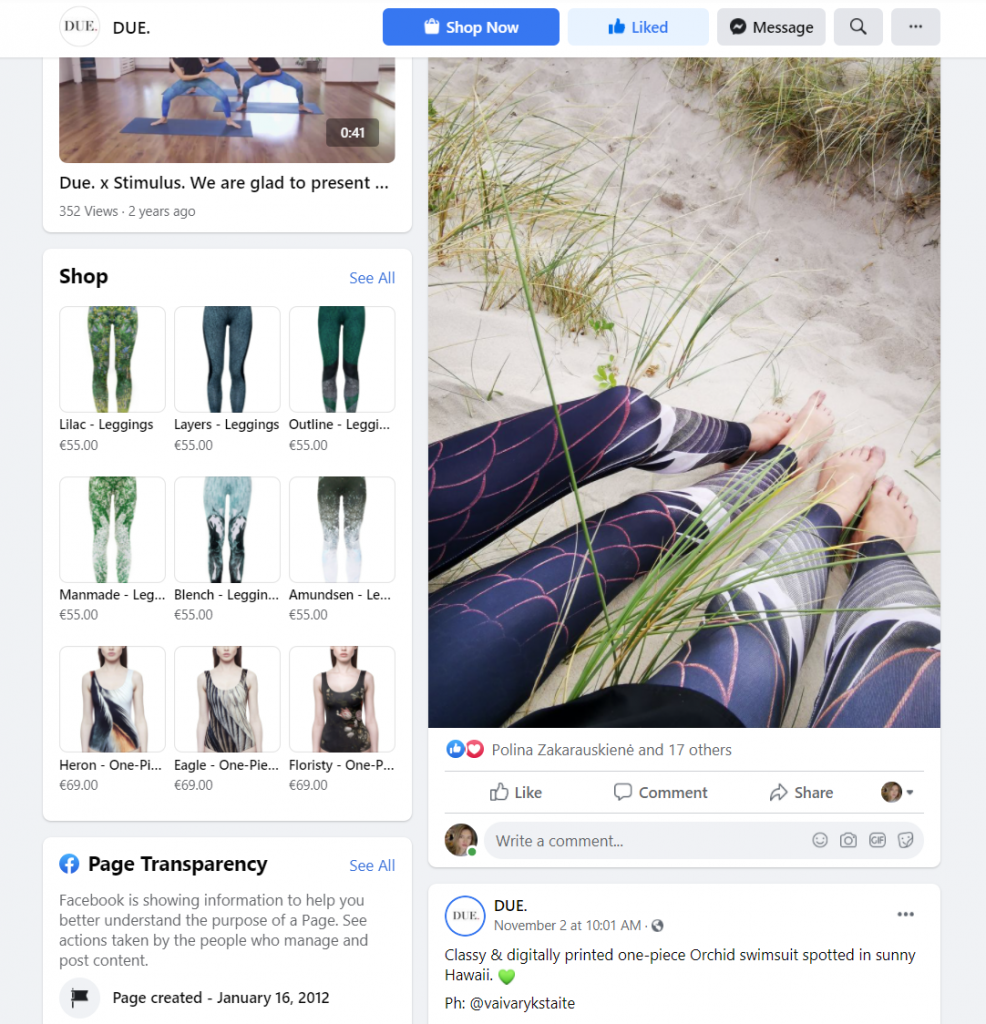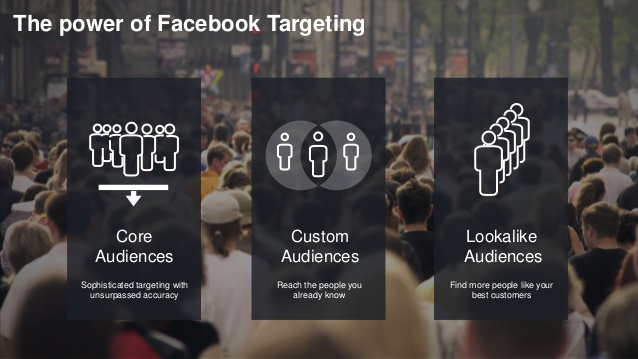
3 Tips to improve your Facebook ads
With Facebook’s organic reach as low as ever, knowing how to run great ads is a must. The good news is that Facebook ads can be as cheap as you want them to be. You can spend as little as $1 per day if you’re a merchant who’s just starting with your online store. The key thing is to use that dollar wisely.
In this blog post, we’ll give you three tips to help you run your Facebook ads more efficiently. You’ll learn how to spy on your competitors’ ads, where to start with testing your targeting and ad creatives, and how to use funneling.
Let’s start.
1. Spy on your competitors’ Facebook ads
First of all, let’s make one thing clear: spying on your competitors is not a bad thing. It even has a name in the marketing world – competitor analysis. All successful online business owners who care about data-driven marketing have at least a few spreadsheets dedicated to their competitor analysis. Why?
Less failed attempts with your own ads
Knowing how your competitors advertise their products and how your target audience responds to their campaigns will help you pass your learning phase quicker. In other words, learn from others’ mistakes, and you’ll make less of your own.
You need to figure out these three questions so that your spying pays off:
- Which tools should you use to check your competitors’ Facebook ads?
- Which metrics or KPIS are the most important to keep an eye on?
- How can you use this information?
Let’s dive into them below.
How to find your competitors’ Facebook ads?
It’s pretty straightforward. First of all, make a list of all the competitors you want to track. Then, find their Facebook pages and check them one by one with the tools below.
Use Facebook’s Ad Library
In the Facebook Ad Library, you can find all the ads running on Facebook apps and services (Instagram including). Advertising is made completely transparent. You can search for any ads, whether you’ve been targeted by them or not.
In Facebook’s Ad Library, you can see:
- your competitors’ ads within 24 hours from the time they get their first impressions;
- any changes made to those ads (also reflected within 24 hours).
Here’s how to find your competitor’s ads in Facebook’s Ad Library:
- Open your competitor’s Facebook page.
- Find the Page Transparency section and click on See All.
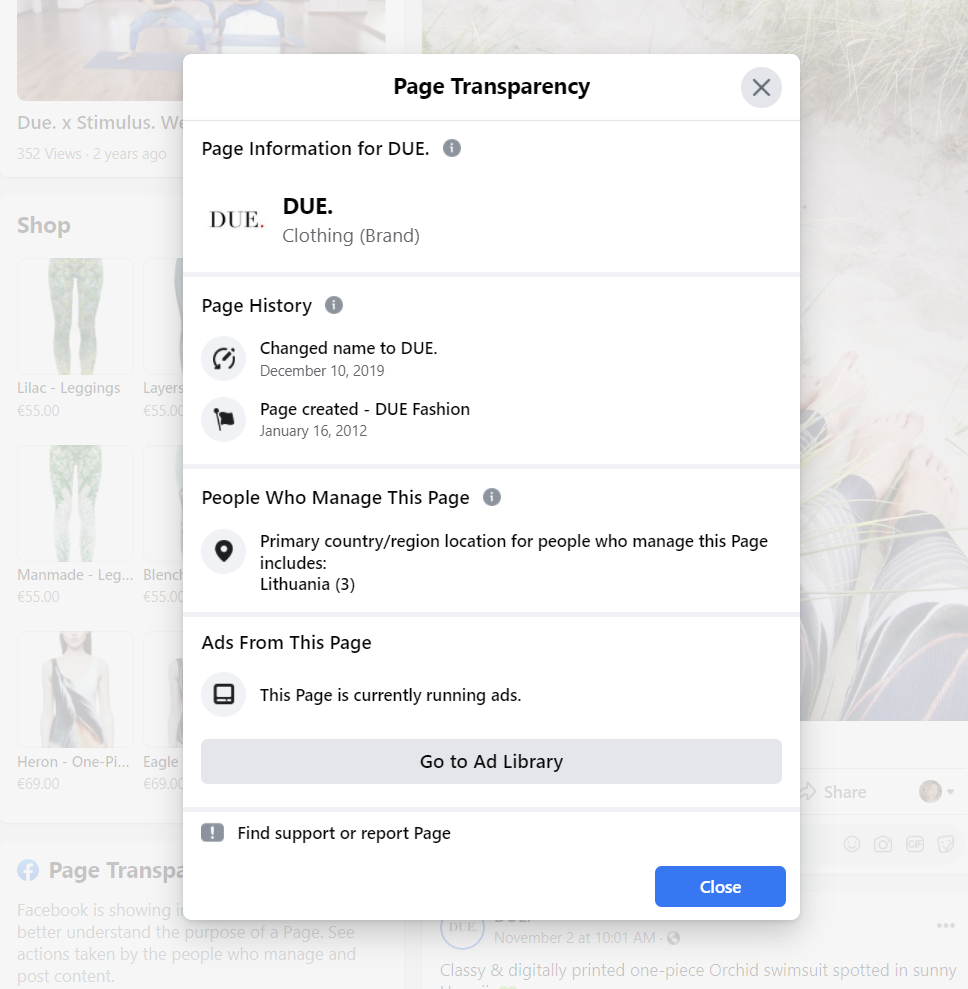
And here it is, you can see all the ads that your competitor is running at the moment.
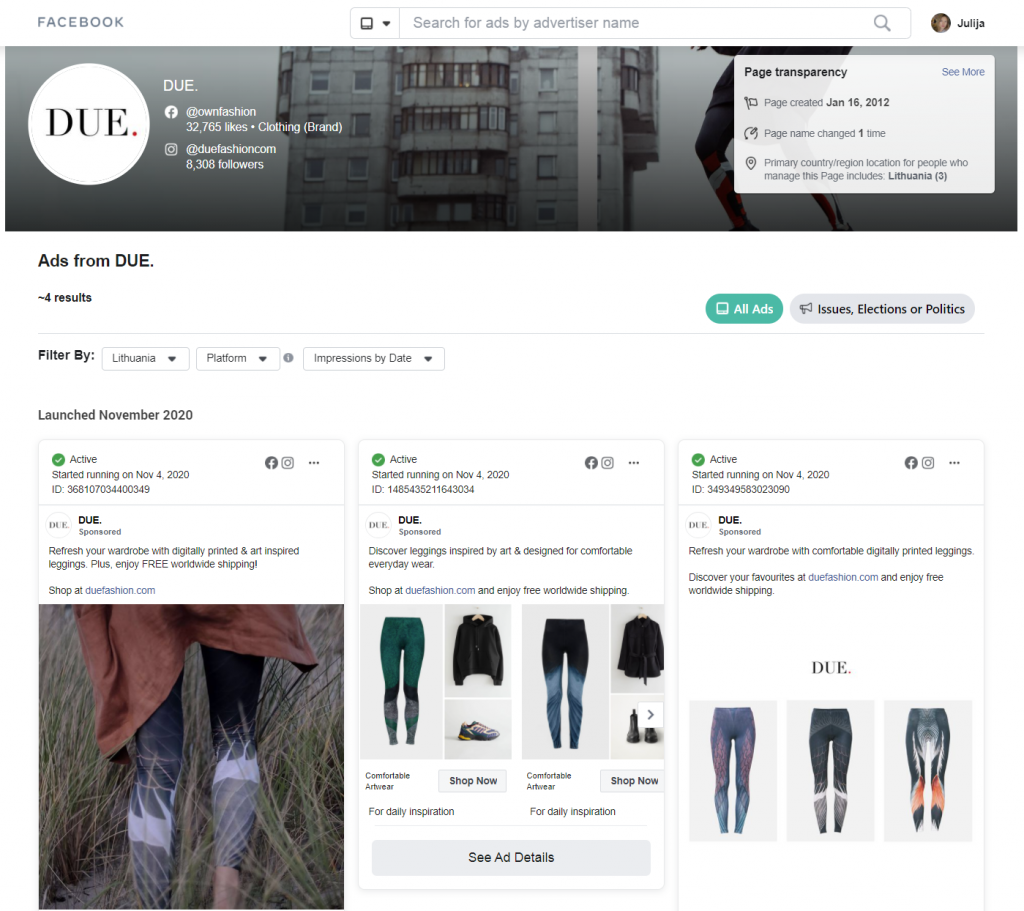
Mistakes to avoid in your competitors’ analysis
- Comparing apples to apples
It’s common for businesses to stay in the loop and only keep an eye on the same few competitors. For example, you may be selling artsy leggings on your online store, so, naturally, you’re only going to look for other stores that also focus on leggings. This way, you stay in the loop and miss out on getting more fresh ideas.
To get a better understanding of what kind of Facebook ads work well, have a look at indirect competitors, too. Search for clothing brands that also sell artsy clothing items, but their items range from leggings to hats and jumpers. Identify their advertising tactics and see what you can learn from them. Plus, your target audience will likely be very similar, so your findings will be relevant to you.
- Checking on your competition only occasionally
Spying on your competitors from time to time will bring the same results as launching your Facebook ads once in a while. With algorithms and general trends in digital marketing constantly changing, you need to be aware of your surroundings. Analyze what’s working and what’s not for your competitors quarterly.
- Being a copycat
While spying on your competition is not a bad thing, copy-pasting their campaigns is. The whole point of analyzing your competitors’ Facebook ads is to give you an idea of what works and what doesn’t, not to save time on coming up with your ad text. While you may slip one or a few times, eventually, people will start to notice, and you may ruin your reputation as a brand.
However, if you find some great creative ideas, it’s okay to adapt them to your ads. That’s the whole point! Just make sure to find your angle for the ad creative (images and text) so that you speak in your voice.
2. Test your targeting and ad creatives
Testing Facebook ads is important because it lets you understand what works best to attract and convert your target audience. Though testing takes time and effort, in the end, you can be sure that you spend your ad dollars on the ads that perform. You get better results with spending less!
There are two main things you should test: your targeting and ad creatives.
First step: Identify your most responsive audience
Facebook gives you three types of targeting:
- Core audiences (based on demographic criteria such as age, interests, and more).
- Custom audiences (based on people who have already shown interest in your business).
- Lookalike audiences (helps you reach people who are similar to your customers).
If these concepts are new to you, and you’d like to learn more about Facebook audiences, check Facebook tips for beginners, and come back then. If not, keep on reading!
Social media professionals recommend combining custom and lookalike audiences to reach the best targeting for conversions. This way, you get an audience (or multiple audiences) that hasn’t interacted with your ads yet but have a high chance of converting.
You may be tempted to use such audiences for testing, but our advice would be to save them for later once you’ve figured out your best ad creatives. Why? You don’t want to bore your hot audiences with multiple testing attempts.
So, even though lookalike audiences built on custom audiences (contact lists, site visitors, or app users if you have such) are probably your most responsive audiences, save them for later.
What should you do then?
Work on building your core audiences.
Core audiences are great if you want to reach more people who don’t know about you yet but may be interested based on their interests and other criteria. You can try testing different locations, education, age, gender, interests, consumer behavior… the list goes on!
Related: Ecommerce CRM and the customer insights it provides
- Build around 5-10 different core audiences according to your buyer personas.
- Test a type of ad creative that you think will do well across all those audiences.
- Find your number one core audience, which can later be used to test your ad creatives.
Once you’ve figured out your most responsive core audience, you can use it to test your ad creatives.
Second step: Test your ad creatives
Within an ad, you can test your:
- headline;
- ad copy (share message);
- call-to-action;
- visuals (image/ video).
As you can see, there are many variables within one ad, which leads us to the number one rule of testing: don’t test multiple things at once! Suppose you put two ads to the test, and they have different images and different CTAs. How will you know for sure which variable brought the most engagement?
Test one variable at once. Run two ads against each other with all the same elements except the headline or any other copy.
PRO TIP: Start with testing images. Images are what catch people’s attention first when they’re scrolling through their news feeds.
Once you know what kind of images work, move on to testing those images with and without text on them. Facebook has recently removed the limit on the amount of text that can be put in an ad image, so you have more freedom in this area. However, it’s still recommended not to go overboard with the text and use a clear and concise copy for the best results.
With the images figured out, now it’s the turn to test your ad copy. Try testing:
- shorter and longer ad text,
- different call-to-actions,
- the use of emojis,
- questions.
Whatever you do, make sure that your ad copy goes together with your image. Also, use a simple language, have one clear call-to-action, and make it easy to understand how your products or services can benefit your potential customers.
3. Get your funneling right
Most importantly, make sure you target the right people with the right messaging. That’s where a marketing funnel becomes useful. Your Facebook ads can fall into three stages:
- Top of the funnel (TOFU).
- Middle of the funnel (MOFU).
- Bottom of the funnel (BOFU).
When creating a new campaign, you need to choose your objective based on your funnel stage.
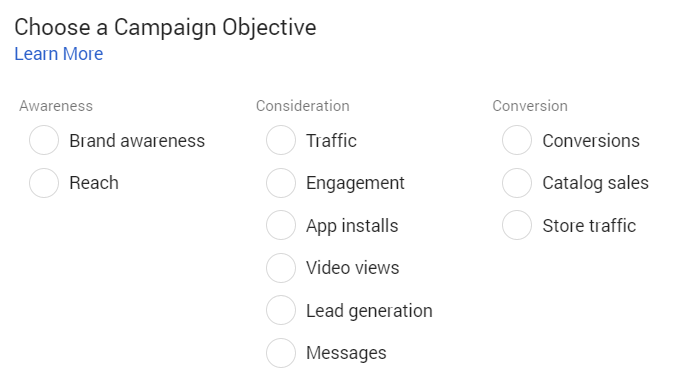
TOFU = Awareness
At this stage of the funnel, your goal is to build your brand awareness. You want to reach people who don’t know that you exist yet but who are likely to become your customers. This is where you’d normally use your core audiences.
One way to attract your target audience’s attention is to use the principles of viral Facebook marketing. You need to create highly shareable ads. If you have the resources to create an engaging video, go for it.
Most importantly, as tempting as it may be, don’t try to sell your products right away. First, you need to spark interest and gain trust, just like Slack did in the example below.
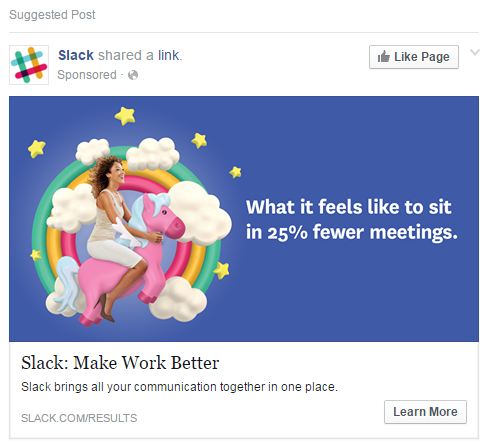
There’s no hard selling here. Slack focuses on how their potential customers could feel with their app, not on their features or amazing offers.
MOFU = Consideration
At this stage, you target prospects from your TOFU campaigns to move them down the funnel. You want to generate leads. One way to do it is to run quizzes, host helpful webinars, or offer downloads. Another great option is to run a conversational Facebook ad – it’s a very easy way to collect contact information such as a phone number or an email address.
BOFU = Conversion
At the final stage, your ultimate goal is to generate sales. To do that, retarget your leads from MOFU with attractive offers. For example, you can run a dynamic catalog ad or retarget your site’s visitors with a discount.
Key takeaway
If you were to remember just one thing from this blog post, let it be this one: Show the right message to the right people. No matter how great your ad creative is or even how great your product is, you’ll spend your ad dollars for nothing if you target the wrong audience. Get your funneling right, and you’ll be on a good path.
This article has been contributed by Julija Televiciute, a freelance copywriter at sixads, an app that provides ad exchange and ad automation services for online stores. Specialized in copywriting, social media, and dog memes, she helps businesses get creative with ideas for content that creates value and sells. Want to know more ways to attract buyers to your online store? Connect with sixads on Facebook, Twitter, LinkedIn, or YouTube.
Build and grow your ecommerce brand
Metrilo’s mission is to help you build your ecommerce brand and win your place in the customer’s heart. We share what we learn from our daily work with product innovators and founders here. Subscribe to our weekly newsletter to get the freshest lessons and conquer your niche.
We promise, no spam.
Thank you for subscribing!
See you soon :-)
